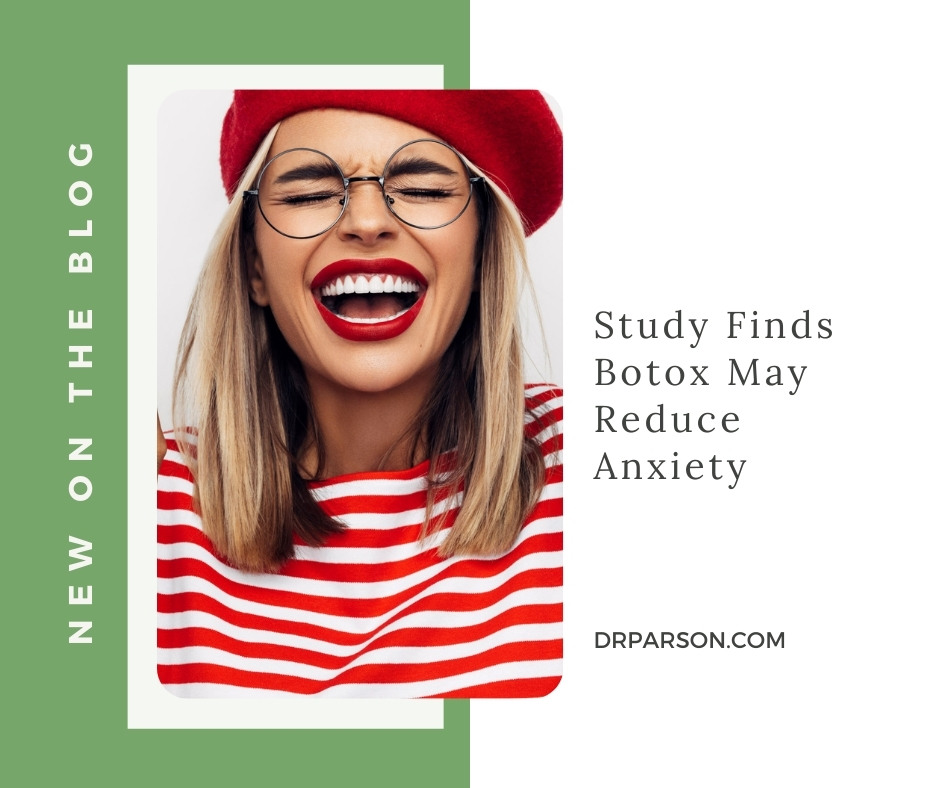
22 Feb Study Finds Botox May Reduce Anxiety
Is there anything Botox can’t do? Parson Skin Center offers expert-injected neurotoxins that stop wrinkles in their tracks. These days, many younger clients use Botox as a preventative measure to “train” muscles not to create unwanted lines, folds, and wrinkles—and, of course, others count on Botox to “erase” those wrinkles in a natural-looking way. Botox has also long been used to treat and prevent migraines as well as unwanted sweating. However, a recent study shows that Botox injections can also help minimize anxiety.
The study was undertaken by the Skaggs School of Pharmacy and Pharmaceutical Sciences located at the University of California, San Diego and involved collaboration with two German physicians. It turns out that those getting Botox in four key sites reported “significant reduced anxiety” compared to patients who were not receiving these injections. One of the authors describes how this study came about, noting how they wanted to find beneficial “side effects” of Botox.
The Many Perks of Botox
At the start of the study, scientists pored over databases to find any mention of reduced anxiety or anxiety-related disorders as a side effect from Botox injections. “Our idea was different,” one author said. “Why don’t we find beneficial benefits?” Findings revealed that risk of anxiety was 22 – 72 percent lower for those receiving Botox. There were four different ways these patients were using Botox that was linked to this reduction including: cosmetic injections, upper and lower limbs for spasms, facial and head muscles to treat migraines, and neck muscles for torticollis.
There was a study in 2020 that used the same database these researchers found, which wrote that there was significantly less depression in those undergoing Botox injections for the same conditions. There was some pushback on this study, with claims that people would “feel happier” if they had fewer wrinkles but those theories have largely been debunked. Now, scientists speculate that the key molecular mechanisms used in Botox are what might be interacting with depression and anxiety symptoms, but that the two are reacting to Botox in different ways. According to researchers, “They may be related, but there are different pathways responsible for anxiety attacks versus depression.”
How it Works with Botox
There are a number of theories currently being considered. For instance, Botox is often used to help with chronic conditions that may exacerbate anxiety, so this might ultimately lead to less anxiety. Of course, further investigation is needed—but for now, take it as a silver lining that your favorite injectable can do so much more than treat lines and wrinkles. However, this isn’t the only beloved injectable at Parson Skin Center.
Kybella is one of the newest members of the injectable family and gets rid of submental fat-causing double chins. It’s an alternative to liposuction and requires a series of treatments using a “stamp” device. Kybella is comprised of deoxycholic acid that dissolves unwanted, excess fat. On average, most people need 4 – 6 treatments for optimal results, and when that fat is gone, it’s gone for good. Still, keep in mind that a double chin can be caused by excess fat, skin laxity, or both. If laxity is at play, skin tightening treatments may be combined with Kybella.
Fillers for All
Botox and dermal fillers go together like Valentine’s Day and chocolate. There are two common signs of aging: lines/wrinkles and lost volume. Dermal fillers can replace volume you’ve lost over the years or give you the volume you’ve always wanted. Most dermal fillers are made of hyaluronic acid (HA), a substance already found naturally in the body. It is not a permanent solution, but depending on how many syringes are injected and the site, some dermal fillers can last up to two years.
For those who prefer a different approach to fillers, there are other “fillers” like Sculptra that work with collagen induction. The results aren’t immediate (like they are with HA fillers), but rather reveal themselves in the months following the injections. Since collagen-building takes time, you can enjoy the benefits for longer than HA fillers in many cases.
Designing Your Ultimate Experience
Most clients find that combination therapy is best for yielding the results they want. Combining Botox with fillers is a common approach, and of course, these non-surgical treatments also pair well with chemical peels and laser skin rejuvenation options. Everyone is unique and we’re here to help you design the best approach for you. Are you ready to amp up your aesthetic and confidence? Let’s get started! Contact Parson Skin Center today by calling the office, or for the quickest response complete the online form.
